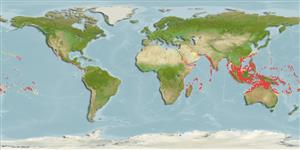Common names from other countries
Issue
Sphyraena nigripinnis Temminck & Schlegel, 1843 considered as valid in CofF (ref. 118474).
Environment: milieu / climate zone / depth range / distribution range
Sinh thái học
Biển Cùng sống ở rạn san hô; Mức độ sâu 0 - 100 m (Ref. 89972). Tropical; 30°N - 24°S
Indo-Pacific: Persian Gulf (Ref.80050); Red Sea and East Africa to the central Indian Ocean and French Polynesia. Eastern Pacific: Mexico and Panama. The exact range is uncertain because of confusion with Sphyraena jello and Sphyraena putnamae (Ref. 9768).
Bộ gần gũi / Khối lượng (Trọng lượng) / Age
Maturity: Lm ? range ? - ? cm
Max length : 170 cm TL con đực/không giới tính; (Ref. 9710); common length : 80.0 cm TL con đực/không giới tính; (Ref. 9768); Khối lượng cực đại được công bố: 7.1 kg (Ref. 40637)
Các tia vây lưng cứng (tổng cộng) : 6; Các vây lưng mềm (tổng cộng) : 9; Tia cứng vây hậu môn: 2; Tia mềm vây hậu môn: 7 - 9. Many dark bars crossing lateral line on body, each bar oblique in upper half, but nearly vertical in the lower; caudal fin largely blackish. No gill rakers on first arch; upper and lower gill arch with rough platelets, each platelet not bearing distinct spine.
Found near current-swept lagoon and seaward reefs (Ref. 9710). Feeds on fishes (Ref. 89972). Usually seen in large semi-stationary schools during the day (Ref. 9768) which have a tendency to occupy the same site for months or even years at a time. Probably disperses at night to feed (Ref. 1602). Often hooked by trolling between dusk and dawn (Ref. 37816). Minimum depth reported taken from Ref. 128797.
Life cycle and mating behavior
Maturities | Sự tái sinh sản | Spawnings | Egg(s) | Fecundities | Ấu trùng
In general, barracudas in large numbers aggegate during spawning season and migrate to specific spawning areas (Ref. 240).
De Sylva, D.P. and F. Williams, 1986. Sphyraenidae. p. 721-726. In M.M. Smith and P.C. Heemstra (eds.) Smiths' sea fishes. Springer-Verlag, Berlin. (Ref. 5491)
IUCN Red List Status (Ref. 130435)
CITES (Ref. 128078)
Not Evaluated
Threat to humans
Reports of ciguatera poisoning (Ref. 4537)
Human uses
Các nghề cá: Tính thương mại; cá để chơi: đúng
Các công cụ
Special reports
Download XML
Các nguồn internet
Estimates based on models
Preferred temperature (Ref.
115969): 26.1 - 29, mean 28.1 (based on 1626 cells).
Phylogenetic diversity index (Ref.
82804): PD
50 = 0.5000 [Uniqueness, from 0.5 = low to 2.0 = high].
Bayesian length-weight: a=0.00724 (0.00339 - 0.01546), b=2.92 (2.74 - 3.10), in cm Total Length, based on LWR estimates for this Genus-body shape (Ref.
93245).
Mức dinh dưỡng (Ref.
69278): 4.5 ±0.80 se; based on food items.
Thích nghi nhanh (Ref.
120179): Rất thấp, thời gian nhân đôi của chủng quần tối thiểu là hơn 14 năm (Preliminary K or Fecundity.).
Fishing Vulnerability (Ref.
59153): Very high vulnerability (90 of 100).
